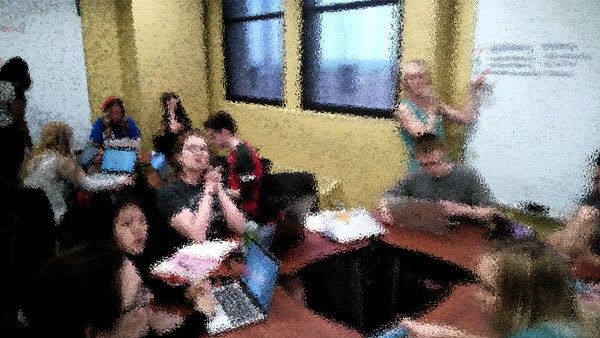By Doug Ward
Authentic assignments can be messy.
That’s not a bad thing. In fact, the messiness helps students deepen their critical thinking, improve their decision-making, learn about themselves, and even take more control over their learning.
That messiness can be challenging for both students and faculty members, though. For students accustomed to a lecture-and-test format, it means grappling with ambiguity and working through failures. For instructors, it means ceding considerable control to students and devoting time to individual and group problem-solving.

Let me give you an example from a journalism class called Infomania, which focuses on research skills and critical thinking. To promote those skills, I challenge students, mostly freshmen and sophomores, to solve a problem or answer a question using information and digital tools. They work in groups to identify elements of the problem, conduct research, and create a prototype of a solution.
The results have been impressive, but the process is messy. Students must identify problems and focus questions; identify sources; brainstorm solutions; distribute work among groups; set deadlines, and ultimately give shape to their ideas. I set aside one class period each week for group work, moving among the groups, challenging their thinking, pushing for context, and guiding them toward appropriate resources. I also bring in librarians, who provide important perspectives on finding information.
The approach I take in the class combines elements of team-based learning and problem-based learning, combined with a dose of entrepreneurial thinking. If you plan to try something similar, keep a few things in mind:
Embrace the messiness. It takes a while for students to come to grips with the idea of controlling their own learning. I provide material at the beginning of the semester on how to do that, but students take vastly different paths. Those who have mastered test-taking often struggle the most, but all students need reassurance and guidance. I give one piece of advice so much that it is almost a class mantra: “Try it.”
Provide choices. Choice motivates students. I rarely say no to ideas, but I spend a lot of time helping students hone their questions, think through what they really want to discover, and why they think that is significant.
Trust students. All too often, instructors set low expectations and assume that students need to be told what to do at every step. That teaches students to be passive consumers of information and of education. I’ve found that students respond well to challenges and high expectations. Consider that for years, students have told the National Survey of Student Engagement that they expected college to require more work than it really does. If we give students meaningful work, they will respond to the challenge.
Give students time. I devote a least one of two classes each week to group work. Many groups still meet outside class, especially later in the semester, but time in class is crucial. None only does it create a regular schedule for group meetings, but it provides a regular time for me to meet with the groups. As I rotate among the groups, I can answer questions, offer advice and head off potential problems. When I encounter questions that other groups need to know about, I can then provide a mini-lecture or simply provide answers that the entire class needs to know.
Don’t expect miracles. My approach to Infomania has led to such projects as a digital survival guide for freshmen, an e-book on KU traditions, an interactive guide for finding study spaces on and off campus, a prototype of an app for basketball camping, and a guide for matching volunteers and organizations. I’ve also had many shallow projects. Even with those, though, students learned to research and think through problems more effectively.
Nearly all students struggle with this process. That’s important because it forces them out of passivity and empowers them to take control over their own learning. Here’s how one student described the process in an end-of-semester self-evaluation:
“In other courses I have taken at various levels of schooling, it was essentially me pleasing the teacher and nodding my head. In this class, I was forced to take the lead and complete my work on my own. This required focus and organization that had never been required before. Although at the beginning of the class I despised it, I have come to realize that this is how the workplace will be. There is nobody providing you with the guides to succeed. You have to take it on yourself. This class has taught me that.”
Other students haven’t been as positive. Nearly all recognize the importance of authenticity, though.
More on authentic learning: The latest issue of Teaching Matters includes many examples of how faculty members at KU have approached authentic learning.
Doug Ward is the associate director of the Center for Teaching Excellence and an associate professor of journalism. You can follow him on Twitter @kuediting.